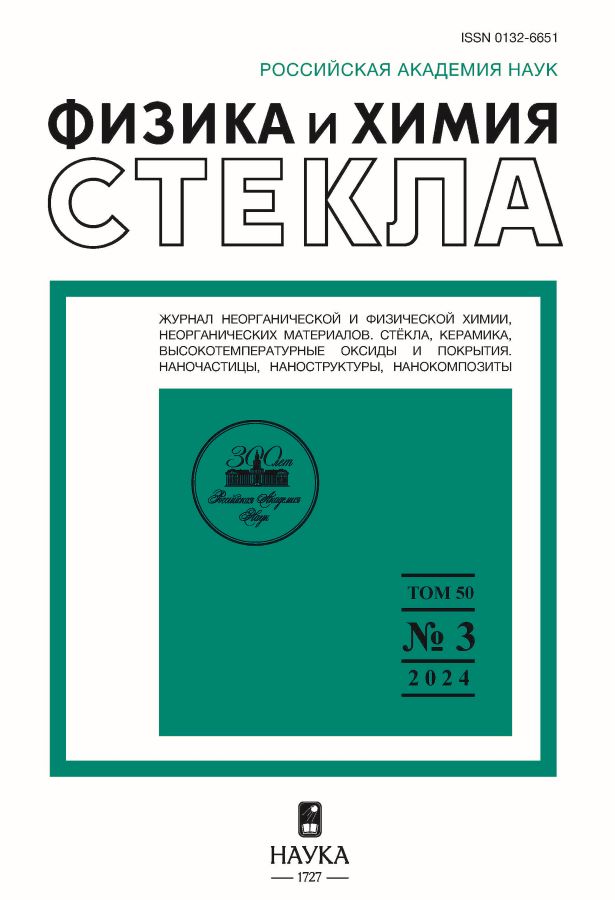Получение керамических композитов на основе циркона и оксида гафния с использованием наноразмерных порошков-прекурсоров
- Авторлар: Уголков В.Л.1, Ковальчук Н.А.1, Осипов А.В.1, Мезенцева Л.П.1
-
Мекемелер:
- Институт химии силикатов им. И. В. Гребенщикова РАН
- Шығарылым: Том 50, № 3 (2024)
- Беттер: 39-50
- Бөлім: Articles
- URL: https://gynecology.orscience.ru/0132-6651/article/view/663261
- DOI: https://doi.org/10.31857/S0132665124030043
- EDN: https://elibrary.ru/PNKLMT
- ID: 663261
Дәйексөз келтіру
Аннотация
Золь-гель методом с раздельным осаждением компонентов синтезированы наноразмерные порошки-прекурсоры (1-х)ZrSiO4–хHf(OH)4, для получения керамических композитов (1–x)ZrSiO4–xHfO2. Термическое поведение порошков-прекурсоров изучали методом ДСК/ТГ. Путем спекания на воздухе в интервале температур 1000–1300°C порошков, предварительно прокаленных при 850°C, получены керамические композиты, определена их микротвердость. Методом РФА определен их фазовый состав.
Толық мәтін
Авторлар туралы
В. Уголков
Институт химии силикатов им. И. В. Гребенщикова РАН
Email: la_mez@mail.ru
Ресей, Санкт-Петербург
Н. Ковальчук
Институт химии силикатов им. И. В. Гребенщикова РАН
Email: la_mez@mail.ru
Ресей, Санкт-Петербург
А. Осипов
Институт химии силикатов им. И. В. Гребенщикова РАН
Email: la_mez@mail.ru
Ресей, Санкт-Петербург
Л. Мезенцева
Институт химии силикатов им. И. В. Гребенщикова РАН
Хат алмасуға жауапты Автор.
Email: la_mez@mail.ru
Ресей, Санкт-Петербург
Әдебиет тізімі
- Grechanovsky A.E., Urusov V. S., Eremin N. N. Molecular dynamics study of self-radiation damage in mineral matrices // J. Struct. Chem. 2016. V. 57. № 6. P. 1243–1262.
- Ferriss E.D.A., Ewing R. C., Becker U. Simulation of thermodynamic mixing properties of actinide-containing zircon solid solutions // Am. Mineralog. 2010. V. 95. P. 229–241.
- Burakov B.E., Anderson E. B., Rovsha V. S., Ushakov S. V., Ewing R. C., Lutze W., Weber W. J. Synthesis of zircon for immobilization of actinides // Mrs. Proc. 2011. V. 412. P. 33–39.
- Williford R.E., Begg B. D., Weber W. J., Hess N. J. Computer simulation of Pu3+ and Pu4+ substitutions in zircon // J. Nucl. Mater. 2000. V. 278. № 2–3. P. 207–211.
- Wang L., Liang T. Ceramics for high level radioactive waste solidification // J. Adv. Ceramics. 2012. V. 1. № 3. P. 194–203.
- Orlova A.I., Ojovan M. I. Ceramic mineral waste-forms for nuclear waste immobilization // Materials. 2019. V. 12. № 16. Article number 2638 (45 p.)
- Уголков В.Л., Ковальчук Н. А., Осипов А. В., Мезенцева Л. П. Золь-гель синтез наноразмерных порошков и получение керамических композитов на основе циркона и оксида циркония // Физ. хим. стекла. 2023. Т. 49. № 5. С. 522–531.
- Уголков В.Л., Ковальчук Н. А., Осипов А. В., Мезенцева Л. П., Акатов А. А. Керамические композиты на основе циркона и оксида циркония // Новые огнеупоры. 2023. № 9. С. 28–33.
- Curtis C.E., Doney L. M., Johnson J. R. Some properties of hafnium oxide, hafnium silicate, calcium hafnate, and hafnium carbide // J. Am. Ceram. Soc. 1954. V. 37. № 10. P. 458–465.
- Торопов Н.А., Барзаковский В. П., Бондарь И. А., Удалов Ю. П. Диаграммы состояния силикатных систем. Справочник. Выпуск второй. Металл-кислородные соединения силикатных систем. Изд-во «Наука», Ленингр. отд., Л., 1969. С. 181–193.
- Chaubey G.S., Yao Y., Makongo J. P.A., Sahoo P., Misra D., Poudeu P. F.P., Wiley J. B. Microstructural and thermal investigations of HfO2 nanoparticles // RSC Advances. 2012. V. 2. № 24. P. 9207–9213.
- Hong Q.-J., Ushakov S. V., Kapush D., Benmore C. J., Weber R. J.K., van de Walle A., Navrotsky A. Combined computational and experimental investigation of high temperature thermodynamics and structure of cubic ZrO2 and HfO2 // Scientific Reports. 2018. V. 8. N1. Article number 14962.
- Tang J., Fabbri J., Robinson R. D., Zhu Y., Herman I. P., Steigerwald M. L., Brus L. E. Solid-solution nanoparticles: Use of a nonhydrolytic sol-gel synthesis to prepare HfO2 and HfxZr1-xO2 nanocrystals // Chem. Mater. 2004. V. 16. № 7. P. 1336–1342.
- Никишина Е.Е., Лебедева Е. Н., Дробот Д. В. Индивидуальные и биметаллические маловодные гидроксиды циркония и гафния: Синтез и свойства // Журн. неорг. химии. 2015. Т. 60. № 8. С. 1018–1027.
- Chaubey G.S., Yao Y., Makongo J. P.A., Sahoo P., Poudeu P. F.P., Wiley J. B. Synthesis and thermal stability of HfO2 nanoparticles // Mater. Res. Soc. Symp. Proc. 2010. V. 1256. Symposium N – Functional Oxide Nanostructures and Heterostructures, 2010, 1256-N16–35.
- Никишина Е.Е., Лебедева Е. Н., Прокудина Н. А., Дробот Д. В. Физикохимические свойства маловодных гидроксидов циркония и гафния и продуктов их термолиза // Неорг. матер. 2015. Т. 51. № 12. С. 1284–1292.
- Polovov I.B., Bataev Y. S., Afonin Y. D., Volkovich V. A., Chukin A. V., Rakhmatullin A., Boča M. Synthesis of HfO2 from hafnium hydroxide hydrate // J. Alloys Compds. 2019. V. 790. P. 405–412.
- Таран Г.С., Баранчиков А. Е., Иванова О. С., Жижин К. Ю. Гидротермальный синтез водных золей нанокристаллического HfO2 // Журн. неорг. химии. 2020. Т. 65. № 6. С. 725–730.
- Заплишный В.Н., Строганов А. М., Скородневская Л. А., Строганов В. М., Котляров И. С., Заводное В. С. Каталитический гидролиз алкоксисиланов и получение гидроизоляционных материалов на их основе // Химия и химическая технология. 1991. Т. 34. № 6. С. 4–15.
- Мурашкевич А.Н., Камлюк Т. В., Жарский И. М. Получение пленок SiO2 золь-гель методом и их свойства // Труды Белорусского государственного технологического университета. Серия 3. Химия и технология неорганических веществ. 2003. Вып. XI. С. 92–107.
- Rakhimova O.V., Magomedova O. S., Tsyganova T. Investigation of hydrolytic polycondensation in systems based on tetraethoxysilane by DK-spectrophotometry method // Glass Phys. Chem. 2019. V. 45. № 6. P. 419–427.
- Kwon S.Y., Jung I.-H. Critical evaluation and thermodynamic optimization of the CaO–ZrO2 and SiO2–ZrO2 systems // J. Europ. Ceram. Soc. 2017. V. 37. № 3. P. 1105–1116.
- Rendtorff N.M., Grasso S., Hu C., Suarez G., Aglietti E. F., Sakka Y. Zircon-zirconia (ZrSiO4–ZrO2) dense ceramic composites by spark plasma sintering // J. Eur. Ceram. Soc. 2012. V. 32. № 4. P. 787–793.
- Кульметьева В.Б., Красный Б. Л., Тарасовский В. П., Красный А. Б. Цирконовая керамика с пониженной теплопроводностью // Конструкции из композиц. матер. 2009. № 3. С. 48–54.
Қосымша файлдар

















